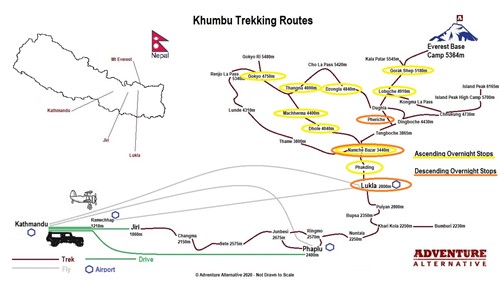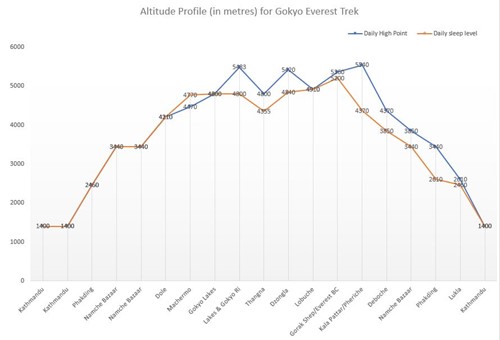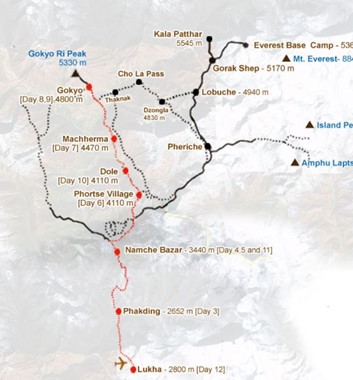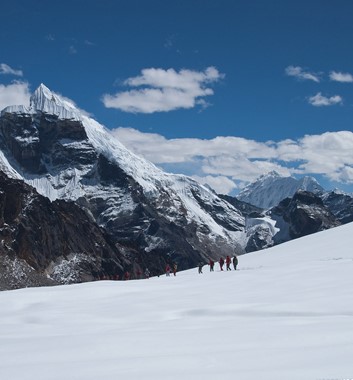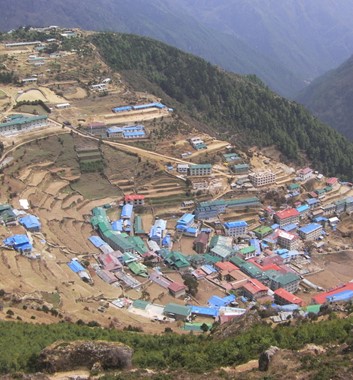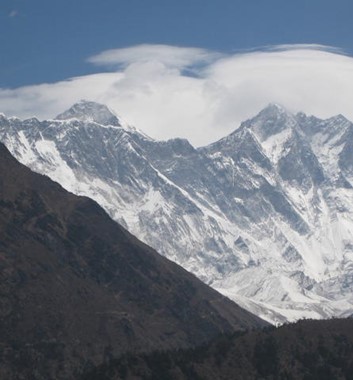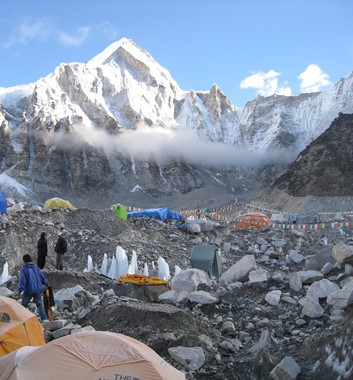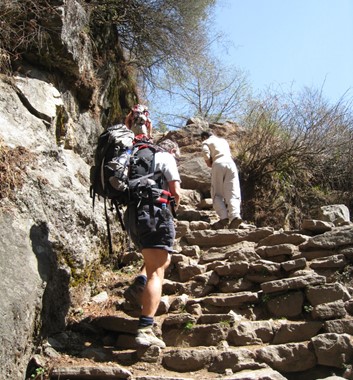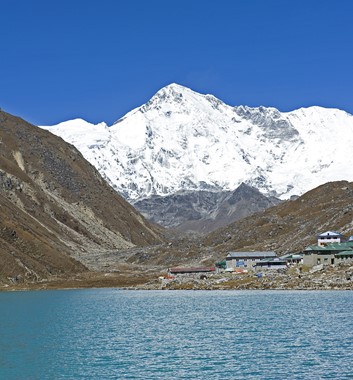Overview
This is one of the more adventurous treks in the Everest region of the Himalayas, following the high route pass of Cho La (5330m) into the Base Camp of Mount Everest. This ascent follows the Dudh Koshi and Khumbu valleys from the homeland of the Sherpa people to the Gokyo valley, which provides breath-taking views of four 8,000m peaks; Everest, Cho Oyu, Makalu and the largest glacier in Nepal, the Ngozumpa glacier. We visit the turquoise Gokyo lakes before following the high route pass of Cho La (5330m) and then drop into the Khumbu Valley and the base camp of Mount Everest.
Summary of the Gokyo Lakes Trek Itinerary
The Gokyo Lakes trek is a 20 day holiday (21 including return travel to Nepal) of which 17 days of the journey are trekking. From Kathmandu there is a short flight to Lukla, but you can choose to walk in from a lower altitude if you prefer (please contact us for details and options). The short flight from Kathmandu (1400m) to Lukla (2866m) takes about 45 minutes. We then follow the Dudh Koshi river valley towards the bustling market town of Namche Bazaar which has a great atmosphere, perfect for soaking up the magnificent mountain scenery. Awe-inspiring views of some of the biggest mountains in the world provide a dramatic backdrop as you venture further into the Khumbu valley. After trekking to Gokyo, the return follows the route through Everest Base Camp, an ascent of Kalar Pattar for close-up views of Everest, down to the stunning Tengboche Monastery, Khumjung village, Namche Bazaar and finally back to Lukla.
With Gokyo Ri standing at 5483m, the Cho La Pass at 5330m, Everest Base Camp at 5360m and Kala Patthar at 5545m, the Gokyo Lakes trek gains a total of 2679 metres from Lukla and 4145 metres from Kathmandu. The ascent to altitude is slow and allows for excellent acclimatisation.
You can trek to Gokyo Lakes from March to June, and September to November. Private trips are welcomed and available for groups like families, corporate events, schools or charities. We have our own office and guesthouse ready and waiting for any dates you may prefer.
Days 1 & 2 : Arrival and preparation/rest day/ sightseeing in Kathmandu
Days 3 - 13 : Fly to Lukla and trek up to Gokyo, cross the Cho La pass and drop into Everest Base Camp
Days 14 - 17 : Climb Kala Pathar and start trek back down to Lukla (includes an additional weather day)
Day 18 : Fly to Kathmandu
Day 19 : Depart for Home (or go on another Nepal adventure)
Gokyo Lakes Trek Route Map
Click on the Map for a larger version.
GOKYO LAKES TREK LENGTH AND TERRAIN
The trek is on a well trodden path all the way though this can be rocky and uneven in parts. It is not precipitous and there is no rock climbing or ‘mountaineering’ which requires equipment. It is a walk all the way, although some of the hills can be steep and never-ending! If the weather is bad then the Cho La pass can be slippy and some simple pull on boot spikes (not crampons) can be a handy thing to have in your pack.
Poles are useful, depending on conditions and especially so if you have problems with knees and if you have a personal preference for using them. Higher up, the open slopes and moraine may give you added reassurance with a pole, but again the path is quite easy to follow.
The treks highest ascent to Gokyo Ri, is not difficult but occasionally slippery underfoot.
Lightweight hiking boots with a high ankle are recommended for the Gokyo Lakes trek, to protect you against possibly going over on an ankle, but heavy boots will be hot and heavy and cumbersome. Cross trainers are popular, but cold in the morning up high.
GOKYO LAKES TREK ALTITUDE PROFILE
Click image to open in a new tab
ACCOMMODATION ON THE GOKYO LAKES AND EVEREST BASE CAMP TREK
Accommodation throughout the trek is in comfortable lodges (formerly known as tea houses) which are run by Sherpa families. Each lodge has a central communal area with a large stove that provides heat and a cosy atmosphere. There are books to read and plenty of people to chat to. The bedrooms are unheated and generally have two beds with mattresses, pillows and a blanket. You will need to bring a sleeping bag (3 season is normally enough) and we'd recommend a pillow case.
The lodges generally have showers which are powered by gas and they mostly use sit down flush toilets, though some lodges do also have squat toilets. Food on the trek is very good quality, and a mixture of local Nepali / Sherpa food and western recipes. Burgers and chips are a common meal, as is dal bhat with rice. You will find everything from fresh pastries to beer, stir fries to deep fried Mars bars available in the lodges and shops a Nepal price guide can be found here. And there are many shops selling all types of drinks and snacks, sweets and chocolate. The biggest challenge will be avoiding all the unhealthy foods and sticking to a simple diet of rice and dal!
PACKING LIST FOR GOKYO LAKES TREK
The basic idea of the kit that you need to take is to keep you warm, dry, protected from the sun, able to move comfortably in the mountains and able to be comfortable in the evenings and at night.
You will be given a detailed kit list after booking, but the main points to cover are as follows:-
- BAGS - Rucksack or duffle bag for a porter to carry plus a day pack to be carried by you
- SHELL - Top and bottom waterproofs to keep off wind/rain
- LAYERS - Shirts, trousers, shorts, Tshirts, jumpers and jackets, hats and gloves
- BASELAYER - Thin layers to wick away any sweat and to wear for cold mornings
- FEET - Comfortable boots with a good sole and ankle support. Lighter footwear to change into in the evenings.
- SLEEPING - Warm sleeping bag (3 or 4 season) to get a good nights sleep at the lodges (they also have blankets)
- DRINKING - Water bottles should be hard plastic (Nalgene), not throwaway bottles.
- WASHING & MEDICAL - wash kit, towel, first aid kit
- SUN CARE - sunglasses, sunhat
- TREKKING - trekking poles, umbrella, dry bags
- PERSONAL ITEMS - cameras, books, music
We also hire lot's of equipment which can be seen in the 'Extras' tab. If you look at the 'More Information' section you will find in-depth details covering a Packing List for Nepal, Trekking Boots, Sleeping bags and Local prices. In Kathmandu has an area called Thamel which is full of hundreds of equipment shops, each one an emporium of new, used, quality and fake equipment all very reasonably priced for rental and buying. You can buy almost anything needed for any trek.
FREQUENTLY ASKED QUESTIONS (FAQS) FOR TREKKING TO EVEREST BASE CAMP VIA GOKYO LAKES
Below are a few commonly asked questions but do also check out our Related Blogs section and also the 'More Information' section also on this page which covers every question you may have for trekking to the Gokyo Lakes and Everest Base Camp!
WHAT EXPERIENCE IS NEEDED TO TREK TO THE GOKYO LAKES AND EVEREST BASE CAMP?
The trek is not a forced march and the pace is always slow, the days generally being shorter than a day hike at home. You can't train for altitude and previous experience of it is not needed as our approach is slow and our itinerary allows for good and gradual ascent to high altitude; this gives you the best chances of enjoying the trek without any or major affects.Do have a look at our Acclimatising Safely info page.
HOW FIT DO I NEED TO BE TO TREK TO EVEREST BASE CAMP VIA THE GOKYO LAKES?
We do recommend that you embark on a good fitness programme at least 6 weeks prior to your trip, and one that builds up general stamina and specific leg muscle groups. There is nothing like hiking with a rucksack to train, so the best advice is to get out into the hills as often as you can. You are likely to carry about 5 kilos in your day sack so this is a good weight to work with.
If you are going to be using the gym then concentrate on step machines which work on the thigh and calf muscles, and try to build your heart rate up to 50% above resting rate. Any cardiovascular activity is good, but remember that swimming will not train the correct muscle groups so it must be added to other exercises to be effective. Exercise groups like bodypump, Pilates and aerobic are all excellent preparation for a trek like this, especially those which work on core strength, balance and stability.
Do have a read of our various Blogs about treks in Nepal and also the 'More Information' section, both have tabs on this page and will answer every question you may have! We also have a lot of useful information on our Nepal Preparation page.
Dates & Bookings
Itinerary
Gokyo Lakes Trek itinerary
| Day | Elevation | Travel Time | Info |
|---|---|---|---|
| 1 | 1400m | Arrive in Kathmandu and transfer to Hotel or Adventure Alternative guesthouse. | |
| 2 | 1400m | Rest day and acclimatisation to jetlag, sightseeing plus trek briefing. Possible drive to Ramechhap** - see 'Lukla Flight' details below. | |
| 3 | 2460m | 2 hours walking | Flight* from Kathmandu into the mountains and the town of Lukla. From there a gentle downhill walk to Phakding or Jorsale along the edge of the Dudh Kosi River. Easy, well-used, busy path of porters and yaks, surrounded by forest on the sides of the valley. |
| 4-5 | 3440m | 6 hours walking | Uphill to the Sherpa capital in the heart of the Khumbu region, Namche Bazaar. Initially follow the valley to Monjo where you enter the National Park, then criss-cross the river a few times and start a long unrelenting path uphill, with spectacular bridges spanning deep gorges. Leave the coniferous forest behind, and arrive at a huge natural amphitheatre with the blue-roofed houses spread around the sides. Namche is the major trading centre of the Khumbu, with Tibetans crossing the high Nangpa La Pass to reach the bustling Saturday morning market. Nowadays there are also many equipment shops, internet, bank, post office, cafes, bars, lodges and hire shops. Rest here for a day and take the chance to visit the Everest Museum. |
| 6 | 4210m | 5 hours walking | Walk to Dole (4210m), via an easy path to Sangnasha. Climb uphill until Mong La, where we have lunch. After lunch it is downhill to Phorche Tanga. A pleasant walk through some forest then brings us to Dole, where we stop for the night. |
| 7 | 4470m | 3-4 hours walking | Today we head to Machermo, following a quite easy grassy path. You are provided with views of Cho Oyu (8200m) as we climb gradually moving up the river valley passing Lhabarma and Luza to reach our destination of Macherma (4470m). |
| 8-9 | 5483m | 3 hours walking | There is quite a steep climb to kick us off, and due to the increase in altitude we spend two nights at the lakes to enjoy the views. On day 9 it is an early start, around 3am to climb Gokyo Ri (5483m) for sunrise. It takes around 2 ½ hrs to reach the summit, and you are rewarded with spectacular views of Everest, Lhotse, Ama dablam, Pumori, Thambersku, Khangteka, Tensum Khang Gunnel and Cho La Che before returning to Gokyo Lakes for the remainder of the day. |
| 10 | 4355m | 3-4 hours walking | Cross the Gokyo glacier and stay in Thangna at the foot of the Cho-La Pass for the night. |
| 11 | 5420m | 7-8 hours walking | Today is another early start, around 3am for a 2 hour climb towards the Cho la La Pass (5420m). From here there is a 2 hour descent to Dzongla (4840m), with stunning views to accompany you. |
| 12 | 4910m | 3hours walking | An easy day with about 3hrs walking on relatively flat terrain, to Lobuche, which is alongside the huge Khumbu Glacier. There are many stupas erected in memory of Sherpas who have died on expeditions. Few plants live up here and it will be much colder in the evenings. It is important to walk slowly and listen to your body. Fatigue from lack of oxygen to your muscles is common, but some people may feel nauseous and suffer from headaches. Drink lots of liquid and keep warm, give your body maximum opportunity to recover. |
| 13 | 5360m EBC 5200m sleep | 7 hours walking | Hike on the glacial moraine to the final settlement of Gorak Shep. The views here are spectacular; Nuptse dominates the other side of the valley, behind which the black triangular peak of Everest is just visible. The giant wall of ice ahead is the border with Tibet. Gorak Shep is the last outpost, a small collection of huts just below a shoulder of Mount Pumori called Kala Patthar which is our destination the following morning as it's a fine viewing point for Everest. We'll have lunch at Gorak Shep and then walk on for roughly 1.5 - 2hrs and visit Everest base camp. We trek along the lateral moraine and finally over the Khumbu glacier itself to the base camp at the foot of the Khumbu Ice Fall. Arriving at the small tented city, where climbers congregate to climb the mountain, is a surreal experience. There is plenty of time to soak up the atmosphere, take photos and enjoy the area. After which we drop back to Gorak Shep for dinner and get our heads down before an early start to climb Kala Patthar. |
| 14 | High point 5540m drop to 4370m | 2 + 3hrs hours walking | Early morning climb to the summit of Kala Patthar (5540m) to see sun rise behind the peak of Everest. This is a tough walk in the cold and not to be underestimated. Take warm clothing. Back at the lodge for breakfast and a walk back down past Lobuche, dropping out of altitude to Pheriche at 4370m. |
| 15, 16 | 2460m | 6hrs / day | Over two days a descent via Namche Bazaar to Lukla with various options for accommodation. It is possible to stay in different villages, for example Pheriche, Khumjung, Monjo, but the route is the same as the way up. |
| 17 | 2460m | Additional weather day - this day is here to allow for any delays either flying into our out of the mountains. If the weather is stable you can fly down to KTM or you can spend an extra day in the mountains. Please read our Himalayan Flight Delays info page. | |
| 18 | 2460m | 2 hrs | Lukla flight* to arrive in Kathmandu in the morning and transfer to hotel. Day rest and sightseeing. |
| 19 | 1400m | Depart Kathmandu. If you leave in the morning it is possible to arrive in London the same day. |
*LUKLA FLIGHT
The Lukla flights fly-by-sight, so if there is bad weather there can be delays, which occurs in about 30% of all trips with an average delay being 24 hours. We can be flexible and adapt the itinerary to catch up on lost days, and we include a weather day in the itinerary, but if the planes can’t fly then there is little to do except wait.
Occasionally the planes can’t fly but helicopters can; if you prefer this option, and there is group consensus, we can organise this but there would be a supplemental charge which is normally around $500 per person one way. Please look at our Delayed Flight page so you are fully informed and do consider booking your holiday for a day or so longer just in case you do end up with a delay.
**RAMECHHAP / MANTHALI AIRPORT
Over recent years there has been a change, sometimes with little notice, regarding the airport you fly from to reach / return from Lukla. Traditionally, and still occasionally, you fly from Kathmandu airport, however there are now (mostly) regular seasonal changes that have moved the flight to depart / return from Manthali Airport, which is in a place called Ramechhap. If your flight does depart from Ramechhap we will let you know in advance, as far as possible, as this will impact your itinerary slightly, and there will be additional costs as the airport is a four hour drive from Kathmandu.
We prefer to make this journey on your rest and briefing day (day 2 of the itinerary). Some make this journey at 2am on the day you fly up to Lukla, but this can lead to you being very tired and a very long day. We prefer to drive on the afternoon of day 2 of your itinerary, so that you can relax on the morning of day 2, then enjoy the drive in daylight through the beautiful countryside and communities that you pass en route. This means you will arrive at a decent time to have dinner and get a good nights sleep before you fly up the next morning and start trekking.
If this applies to you then there are additional costs for 1) return road transport to / from Ramechhap and 2) accommodation. You will be accompanied and travel with your trek guide. You will of course save some money with one less night in your Kathmandu hotel. These costs are paid in country to our co-ordinator and they vary depending on the size of the group / vehicle required. As an estimate they can range from £70pp to £140pp for a return land journey and an overnight stay in a local hotel for you and your guide. We will book and manage all of this for you.
Cost
Gokyo Lakes trek cost £1,895.00
We offer an inclusive package. We don't ask for land payments. We include ALL of your meals on the trek, and accommodation for the entire itinerary, and a full itinerary allowing you plenty of time to safely acclimatise, enjoy and explore your surroundings.
INCLUDES
- Airport transfers (to / from Kathmandu airport to Kathmandu, for international & Lukla flights)
- Accommodation in lodges/tea houses (twin rooms with beds and mattresses)
- Three meals per day during the trek with a hot drink (e.g tea, coffee, juices)
- Sagamartha National Park Fees
- Sherpa guides (English speaking, trained in first aid)
- Porters (carries about 15kgs)
- Staff food, insurance and equipment
EXCLUDES
- International flight to Kathmandu
- Accommodation in Kathmandu (~ £15 - £25pp/n) - we can book this for you. Click here for details
- Transfers to / from Ramechhap airport 'IF' required (see 'Lukla Flights' below)
- Meals and drinks in Kathmandu
- Personal costs like drinks, laundry, hot showers, bottled water
- Trip Insurance
- Vis
- Tips
- Sightseeing Tours
Please Note:
Luka Flights - Over recent years there has been a change, sometimes with little notice, of which airport you fly from to reach / return from Lukla. Traditionally, and still occasionally, you fly from Kathmandu airport, however there are now (mostly) regular seasonal changes that have moved the flight to depart / return from Manthali Airport, which is in a place called Ramechhap. If your flight does depart from Ramechhap we will let you know in advance, as far as possible, as this will impact your itinerary slightly and there will be additional costs as the airport is a four hour drive from Kathmandu.
We prefer to make this journey on your rest and briefing day. Some make this journey at 2am on the day you fly up to Lukla, but this can lead to you being very tired and a very long day. We prefer to drive on the afternoon of day 2 of your itinerary, so that you can relax on the morning of day 2, then enjoy the drive in daylight and get to see the beautiful countryside and communities that you pass through. Then arrive at a decent time to get a good nights sleep before you fly up the next day and start trekking.
If this applies to you then there are additional costs for 1) return transport to Ramechhap and 2) accommodation. You will be accompanied and travel with your trek guide. You will of course save some money with one less night in your Kathmandu hotel. The travel costs are paid in country to our co-ordinator and they vary depending on the size of the group / vehicle required. As an estimate they can range from £70pp to £140pp for a return land journey and an overnight stay in a local hotel for you and your guide. We will book and manage all of this for you.
Hotels - We don't include your hotel in Kathmandu as there is such a wide range of choice and styles for all budgets. We offer some recommendations which you can see on the Extras tab and can confirm during your booking process or after. Hotels will usually transfer you from the airport, but if not we're happy to do so.
Meals on Trek - We include three meals per day whilst on trek. It is a common practise on cheaper treks to have a food kitty which would normally add £400 - £500 per person to the cost of a trek, but we provide all meals within the trip price.
Payments - A deposit of £100.00 is required on booking to secure your place and we ask that the remaining balance (trip price minus the deposit) is paid in full 6 weeks prior to your departure. When you book with us you're given your own secure online account which you can access 24/7. Through this account you can edit your booking, add flight, health, insurance and dietary details and also make interim payments. We make payments as flexible as possible and you can choose, if you wish, to pay a bit off your trip fee whenever it suits you.
Value for money - Our prices are competitive and good value, and we offer quality, service, security and an ethical stance on tourism in a developing country. We don’t want to be so expensive to run fewer trips and have our staff idle, but on the other hand we believe that running cheap trips that promote the practice of skimming budgets would result in the porters getting next to nothing, which is something we cannot consider.
Acclimatisation - Our treks allow a good time to acclimatise and as a mountain guiding outfit we always want to ensure the trek is safe. Reducing the number of days may make the price cheaper but the chances of safely reaching base camp also greatly reduce. We follow established mountaineering principles of height gain on all treks to altitude.
Travel Insurance - As soon as you book you should purchase a policy which covers trekking to 5500m this will cover you should any unexpected events force you to cancel. Your policy should also include helicopter rescue in the event of an evacuation.
FLIGHT DELAYS IN LUKLA
The mountain flight in and out of Lukla which is where most treks begin and end in the Khumbu (Everest) region can be delayed due to bad weather. Normally it is for about 24 hours but it can be longer. We recommend you allow some time in Kathmandu after the specified day of the internal flight just in case. There is more information about Himalayan flight delays.
Some people choose to cancel the internal flight and book a helicopter which can fly below the cloud level and is not so determined by the weather. This is possible but there are no fixed prices for a seat on the helicopter. There are now around 12 helicopter companies operating and we can check them all for you.
For a one way place on the helicopter to Lukla can cost around $500.00 minimum. The cancelled portion of your aeroplane flight can be refunded and used to offset this figure, which is about $170.00 for a one way sector, so there would be a balance to pay for the helicopter. You can use your credit card to cover off this additional expenditure.
Unfortunately there is nothing we can do if the flight is delayed. Sometimes you can end up waiting in the airport from early hours to get the 'green light' to go, only to find yourself back in the hotel by mid morning. People do get very frustrated because it can impact on the trekking itinerary. A helicopter is one option, or else to wait until the weather improves. However, if it does not then very quickly a queue of people at either end can build up, and it is always hard to get priority for when the weather clears. The airline companies put as many planes on as possible to clear the backlog.
We try to assist as best we can, but it's important to accept that the route has this potential delay and also that it's advisable to book the international flight home a little later in case the delay affects your return ticket.
There is another option which is to drive to Paphlu and then take a jeep on the new road as far as it will go and then walk to Lukla. This option takes more days - two in total each way currently - and there is a saving but only of about $70 compared to the flight.
Photos
Extras

3 season sleeping bag
A good quality 3 season synthetic mummy shaped bag rated to a low of -12°C and a comfort rating of -5°C. Comes with a liner.

Trekking poles
A pair of adjustable trekking poles.

Island Peak
Ascent of Island Peak (Imja Tse), at 6189 metres one of the most iconic trekking peaks in Nepal which is semi technical requiring climbing equipment. First day up to Chukkung for any gear rental and then onto base camp to meet the Sherpa guide. Early morning start to the summit and back down to base camp and onto Chukkung. Normally 2 days in total.

Hotel Manang
3 nights twin/double standard room in the heart of Thamel in Kathmandu. Hotel Manang is a 4 star establishment with excellent facilities, spacious ensuite rooms and a good restaurant.

Yak and Yeti Hotel
3 nights twin/double standard room in this luxury 5 star hotel offering a blend of modern day sophistication and cultural heritage with its 100-year-old palace and the newly designed structure of the hotel.

Kathmandu Guest House
3 nights B&B in a standard twin or double in the famous 4 star Kathmandu Guest House in Thamel, central Kathmandu. KTMGH is set in beautiful grounds with a number of restaurants and gardens, shops and museum pieces.

Kathmandu Eco Hotel
Budget hotel near city centre, price is for 3 nights double or twin room.
Choose a scheduled date or contact us to set up private dates or a bespoke itinerary. The minimum deposit is £100.00 and the balance is due four weeks before travel.
- Duration 21 days
- Numbers 5 - 15
- Altitude 5483
- Distance 100km
- Challenge Moderate
- Comfort Lodges
- Max altitude 5357m
- Nepal trek food & lodging
- Nepal trekking seasons
- Nepal Trek emergencies
- Nepal trip preparation
- Health and altitude
- Tipping advice
- Travel Insurance
- Trekking boot advice
- Acclimatising safely
- Kathmandu Accommodation
- Nepal trek kit list
- Nepal: Local price guide
- Hygiene on trek
- Travel vaccinations
- Sleeping bag advice
- Porters rights
- Himalayan Flight Delays
- Guest House in Kathmandu


